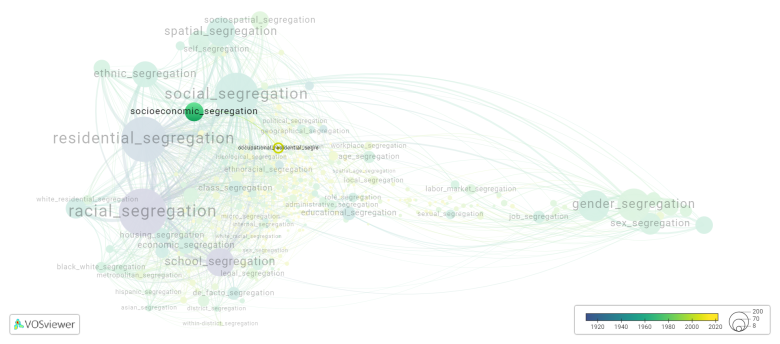Occupational residential segregation: Difference between revisions
(Creating page) |
(Creating page) |
||
| (5 intermediate revisions by the same user not shown) | |||
| Line 17: | Line 17: | ||
Occupational residential segregation is frequently discussed in the literature with the following segregation forms: | Occupational residential segregation is frequently discussed in the literature with the following segregation forms: | ||
[[socioeconomic segregation]], [[social segregation]], [[residential segregation]], [[ethnic segregation]], [[postsocialist segregation]] | |||
[[File:occupational_residential_segregation.png|780x780px]] | [[File:occupational_residential_segregation.png|780x780px]] | ||
For the complete network of | |||
This visualization is based on the study [[Segregation_Wiki:About| The Multidisciplinary Landscape of Segregation Research]]. | |||
year of publication https://tinyurl.com/ | |||
For the complete network of interrelated segregation forms, please refer to: | |||
* [https://tinyurl.com/2235lkhw First year of publication] | |||
* [https://tinyurl.com/2d8wg5n3 Louvain clusters] | |||
* [https://tinyurl.com/223udk5r Betweenness centrality] | |||
* [https://tinyurl.com/244d8unz Disciplines in which segregation forms first emerged (Scopus database).] | |||
==References== | ==References== | ||
==Notes== | ==Notes== | ||
Latest revision as of 07:17, 16 October 2024
Date and country of first publication[1][edit | edit source]
2014
Poland
Definition[edit | edit source]
Occupational residential segregation refers to the phenomenon where people of different occupations or professions tend to live in different residential areas or neighborhoods. This segregation typically occurs due to various factors such as income disparities, educational attainment, and social networks.
In many cities, certain neighborhoods may become predominantly occupied by individuals from specific professions. For example, financial professionals may cluster in affluent urban areas, while teachers may be more concentrated in suburban neighborhoods near schools. This segregation can lead to unequal access to resources and opportunities, as well as reinforce existing social and economic divisions.
Occupational residential segregation can have significant implications for social mobility and economic inequality. The concentration of certain professions in particular areas may limit individuals' access to job opportunities outside their immediate vicinity, potentially restricting their career growth and earning potential.
Additionally, occupational residential segregation can contribute to the perpetuation of racial and ethnic disparities. Certain professions, such as low-wage service jobs, may be disproportionately held by people of color, leading to the concentration of minority populations in specific neighborhoods.
Efforts to address occupational residential segregation often involve policies aimed at promoting affordable housing, improving transportation infrastructure, and providing equal access to educational and employment opportunities across different neighborhoods. These initiatives seek to create more diverse and inclusive communities, reduce economic disparities, and promote social mobility.
See also[edit | edit source]
Related segregation forms[edit | edit source]
Occupational residential segregation is frequently discussed in the literature with the following segregation forms:
socioeconomic segregation, social segregation, residential segregation, ethnic segregation, postsocialist segregation

This visualization is based on the study The Multidisciplinary Landscape of Segregation Research.
For the complete network of interrelated segregation forms, please refer to:
References[edit | edit source]
Notes[edit | edit source]
- ↑ Date and country of first publication as informed by the Scopus database (December 2023).
At its current state, this definition has been generated by a Large Language Model (LLM) so far without review by an independent researcher or a member of the curating team of segregation experts that keep the Segregation Wiki online. While we strive for accuracy, we cannot guarantee its reliability, completeness and timeliness. Please use this content with caution and verify information as needed. Also, feel free to improve on the definition as you see fit, including the use of references and other informational resources. We value your input in enhancing the quality and accuracy of the definitions of segregation forms collectively offered in the Segregation Wiki ©.
Occupational residential segregation appears in the following literature[edit | edit source]
Marcińczak S., Gentile M., Rufat S., Chelcea L. (2014). Urban geographies of hesitant transition: Tracing socioeconomic segregation in post ceauşescu bucharest. International Journal of Urban and Regional Research, 38(4), 1399-1417. Blackwell Publishing Ltd.https://doi.org/10.1111/1468-2427.12073
Tammaru T., Kährik A., Novák J., Leetmaa K. (2015). The 'market experiment': Increasing socio economic segregation in the inherited bi ethnic context of Tallinn. Socio-Economic Segregation in European Capital Cities: East Meets West, 333-357. Taylor and Francis Inc..https://doi.org/
